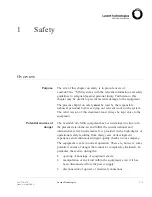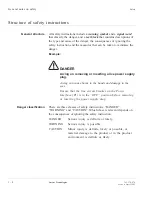
Potential sources of
danger
Beware of the following potential sources of danger which will
remain despite all safety measures taken:
•
Laser radiation can cause damage to the skin and eyes.
•
Laser radiation from optical transmission systems is in a
wavelength range that is invisible to the human eye.
Laser classes
The maximum output power of laser radiation depends on the type of
laser diode used. The international standards IEC 60825 and
DIN/EN 60825 respectively as well as the FDA/CDRH regulations
define the maximum output power of laser radiation for each laser
class in accordance with the wavelength.
The classification scheme is based on the ability of the laser emission
or the reflected laser emission to cause injury to the eye or skin
during normal operating conditions.
Please also refer to
“Laser product classification” (1-16)
.
Laser safety instructions
Observe the following instructions to avoid exposing yourself and
others to risk:
•
Read the relevant descriptions in the manuals before taking
equipment into operation or carrying out any installation and
maintenance work on the optical port units, and follow the
instructions. Ignoring the instructions may result in hazardous
laser radiation exposure.
•
Do not view directly into the laser beam with optical instruments
such as a fiber microscope, because viewing of laser emission in
excess of Class 1 limits significantly increases the risk of eye
damage.
•
Never look into the end of an exposed fiber or an open connector
as long as the optical source is still switched on.
Specific safety areas
Laser safety
Safety
....................................................................................................................................................................................................................................
1 - 1 2
Lucent Technologies
365-374-074
Issue a, April 2002
















































